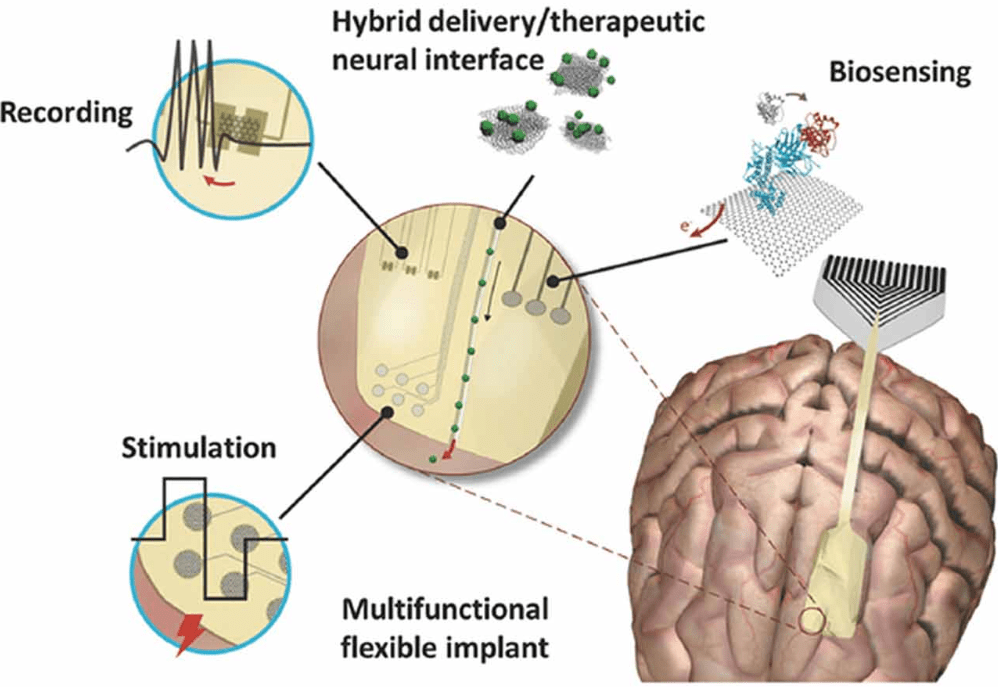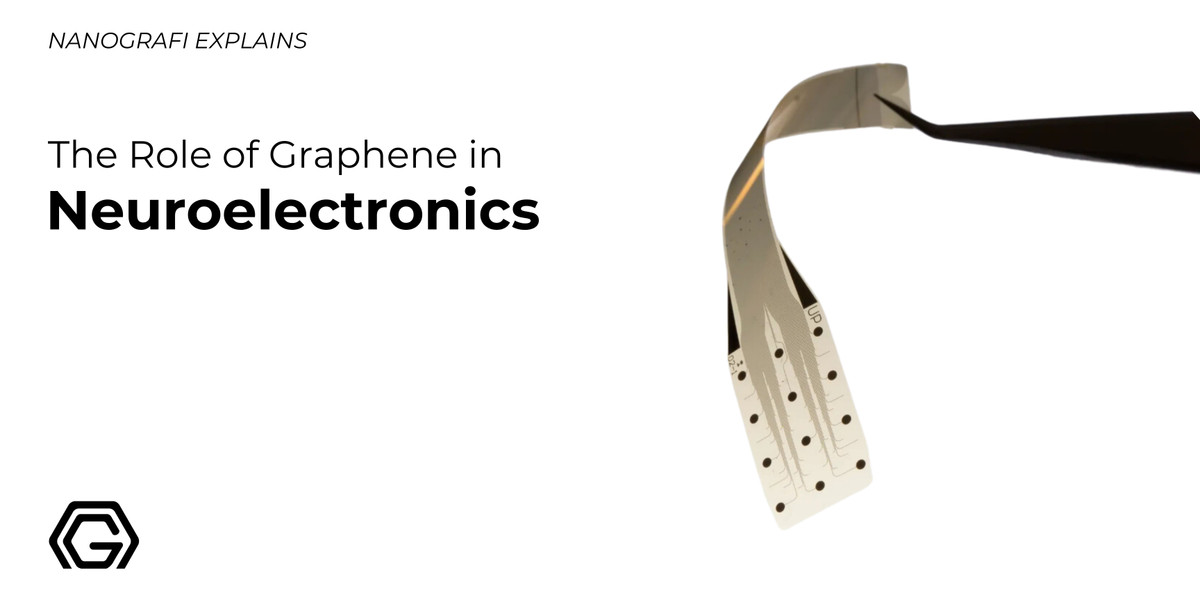The Role of Graphene in Neuroelectronics
Neuroelectronics is an interdisciplinary field that aims to develop devices that can interact with the nervous system. The use of advanced materials such as graphene in neuroelectronics technology contributes to the development of biocompatible and durable implants and thus increases the effectiveness of neuroelectronic devices.
In this article, the basic concepts of neuroelectronics, the role of advanced materials, neuroelectronic applications of graphene and innovative developments in this field will be examined. Discover Nanografi's high quality graphene products with one of the world's highest capacity graphene mass production facilities.
Introduction
The field of neuroelectronics has progressed rapidly in recent years and the integration of advanced materials plays a critical role in the development of this field. Among these materials, graphene stands out with its unique properties in neuroscience and electronics. Thanks to its high electrical conductivity, strength and biocompatibility, graphene stands out as an ideal candidate for the development of more efficient and sensitive neuroelectronic devices.
What is Neuroelectronic?
Neuroelectronics, also known as neurotechnology, is an interdisciplinary field that merges neuroscience and electronic engineering to develop devices that can interface with the nervous system. The goal of neuroelectronics is to create technologies that can monitor, stimulate, or even repair neural functions.
By integrating electronics with biological systems, neuroelectronics enables advancements in brain-machine interfaces, neural prosthetics, and real-time monitoring of brain activity. These innovations are transforming how we treat neurological disorders, manage chronic diseases, and understand the complex workings of the brain.
Use of Advanced Materials in Neuroelectronics
Advanced materials enable the development of implants that can communicate effectively with the nervous system with features such as biocompatibility, biodegradability and multifunctionality in neuroelectronics. These materials contribute to the safe and efficient operation of neuroelectronic interfaces by being used in both central nervous system (brain, spinal cord) and peripheral nervous system devices. Here are some of the main areas describing how advanced materials are used in neuroelectronics:
Biocompatibility: Materials used in neuroelectronic implants must have long-term compatibility with nervous tissue. Metals such as gold and platinum, as well as conductive polymers and carbon-based materials, are commonly used to improve the biocompatibility of implants. Soft and flexible structures prevent mechanical mismatches, preventing implants from damaging nerve tissues and allowing more precise reading of nerve signals.
Biodegradability: In neuroelectronics, biodegradable materials are used for temporary implants that can naturally degrade in the body after functioning for a certain period of time. Such materials are designed to provide temporary nerve stimulation for neurotherapy or nerve regeneration, eliminating a second surgical intervention to remove the implant. These implants include biodegradable polymers (e.g., polylactic acid) and biodegradable metals such as magnesium.
Multifunctionality: Advanced materials enable neuroelectronic devices to fulfil multiple functions simultaneously. For example, materials that combine electrical recording and optogenetic stimulation functions help us understand how brain circuits work by targeting specific nerve cells with optical stimulation. These multifunctional devices allow neural activity to be monitored by both electrical and optical means.
Mechanical Compatibility: Soft and flexible materials can be used instead of rigid implants, minimising mechanical incompatibilities with neural tissues. For example, flexible electrodes made using polymer-based materials allow stable recording of neurological signals over long periods of time and reduce the risk of damage to nerve tissues.
Use of Graphene in Neuroelectronics
Graphene, which consists of a single layer of carbon atoms with a hexagonal lattice structure, is finding more and more uses in neuroelectronics thanks to its high electrical conductivity, flexibility and biocompatibility. These properties allow graphene to be effectively integrated into neural devices that require precise interaction with neural tissues.
Advantages of Graphene-Based Neurodevices
Thanks to graphene's high conductivity, flexibility and biocompatible structure, it interacts safely with the brain and plays a critical role in the development of neuroelectronics.
High Conductivity: Graphene’s superior electrical conductivity allows for more efficient signal transmission and neural stimulation, leading to enhanced performance in both recording and stimulation devices.
Flexibility and Biocompatibility: The flexibility of graphene enables the creation of soft, conformable implants that reduce tissue damage and inflammation. Its biocompatibility ensures that it can be safely implanted in the brain or other neural tissues without causing adverse reactions.
Miniaturization: Graphene’s atomic thickness allows for the development of ultra-thin and lightweight devices, making it possible to miniaturize neuroelectronic systems without compromising performance. This is particularly beneficial for wearable or implantable devices.
Durability: Graphene is highly resistant to corrosion and chemical degradation, making it ideal for long-term implants that need to function reliably over extended periods.
Sensitivity: Graphene-based sensors can detect even small changes in electrical or chemical activity, providing highly sensitive tools for monitoring brain function and developing neurotherapies.
Read our most visited blog about 60 application areas of graphene now.
Applications of Graphene in Neuroelectronics
Thanks to its unique properties, graphene enables a wide range of innovative applications in neuroelectronics, from neural recorders and stimulation systems to flexible implants and neurochemical sensors.
Neural Recording Devices: Graphene is utilized in the development of neural recording electrodes due to its low impedance and high conductivity, which facilitate accurate and efficient signal recording from neurons. This application is particularly relevant in brain-computer interfaces (BCIs) and neural monitoring systems.
A study has shown that graphene-based devices are used to detect nanomotion signals from single-celled organisms such as bacteria. Neural electrodes exploit the biocompatible structure and high conductivity of graphene to record signals from nerve cells, highlighting the sensitive vibration sensing ability of graphene on bacteria. This technology has enabled the rapid and sensitive detection of antibiotic resistance, thus being considered as an important step in medical diagnosis and treatment processes. Examine the article.
Neural Stimulation: The material's excellent charge transfer properties make graphene suitable for neurostimulation devices, such as those used in deep brain stimulation for treating conditions like Parkinson's disease. Graphene-based electrodes can enhance the efficiency of neural stimulation by reducing power requirements.
Flexible Implants: The flexibility and thin structure of graphene enable the creation of neural implants that conform to brain surfaces, reducing mechanical mismatch and potential tissue damage. These implants can be used for long-term neural monitoring.
Neurochemical Sensors: Graphene’s large surface area and electrochemical stability are leveraged in the development of biosensors that detect neurotransmitters and other chemicals in the brain. These sensors aid in real-time monitoring of brain chemistry and related neurological disorders.

Figure 1. Graphene-based neural interfaces designed for diverse neuronal functions, such as recording, stimulation, and biosensing.
CASE EXAMPLE: World’s First Graphene-based Brain Computer Interface
The world's first graphene-based brain-computer interface (BCI) was recently implanted in a patient at Salford Royal Hospital. Developed by INBRAIN Neuroelectronics, this ultra-thin implant breaks new ground in the use of graphene in neurosurgery by distinguishing between healthy and cancerous brain tissue with micrometre precision. The study aims to demonstrate graphene's superior capabilities over conventional materials in neural decoding and surgical applications, which offer significant potential in the treatment of neurological disorders.
Dr David Coope, who performed the operation, said: ‘We are capturing brain activity in areas where traditional materials struggle to provide signal accuracy. Graphene offers ultra-high density for sensing and stimulation. This allows us to perform high-precision surgical interventions while preserving the patient's movement, language and cognitive functions.
Conclusion
Graphene's properties, such as electrical conductivity, flexibility, biocompatibility, and durability, make it suitable for use in neuroelectronics. It enables the development of devices like neural recorders and brain-computer interfaces. The first graphene-based brain-computer interface has demonstrated the potential for precise neural monitoring and improved surgical outcomes. Continued research into graphene-based neurodevices is expected to provide further advancements in the field of neurotechnology.
Discover Nanografi today, featuring an extensive product range that includes graphene, carbon nanotubes, fullerenes, nanoparticles, microparticles, laboratory equipment and more.
Recent Posts
-
The Role of Graphene in Neuroelectronics
Neuroelectronics is an interdisciplinary field that aims to develop devices that can interact with t …4th Oct 2024 -
Holey Super Graphene: The New Face of Supercapacitor Innovation
Supercapacitors are emerging as critical energy storage devices, bridging the gap between conventio …27th Sep 2024 -
Nanosensors in Detecting and Monitoring Water Pollutants
Water pollution remains a significant global issue, with pollutants such as heavy metals, pesticides …20th Sep 2024






